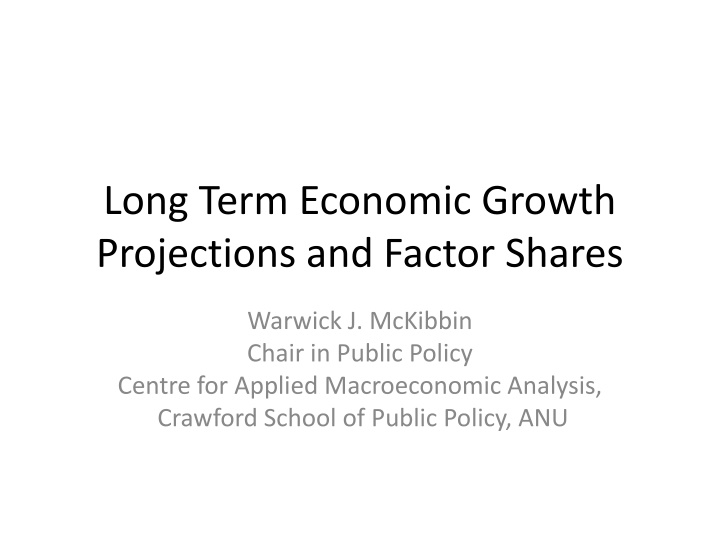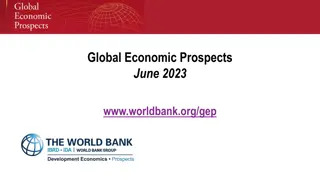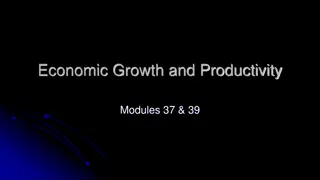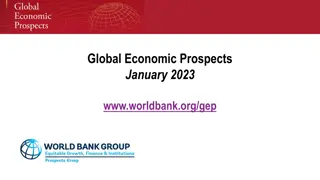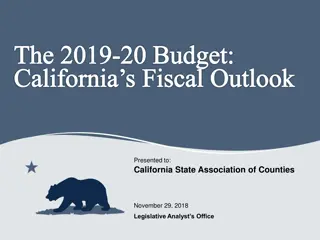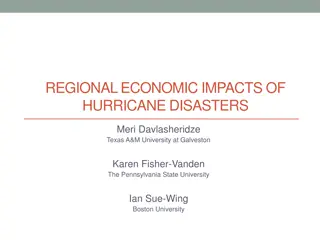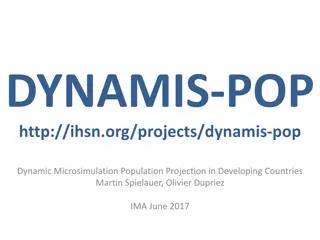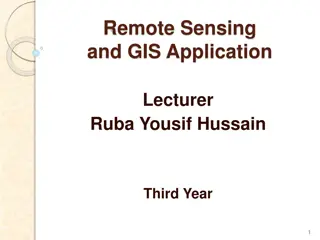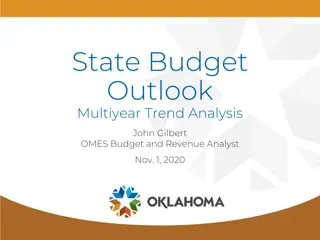Global Economic Growth Projections and Methodologies: Insights and Challenges
Explore long-term economic growth projections, factor shares, and methodologies for forecasting global economic growth. Understand the complexities and historical lessons in predicting future scenarios to inform decision-making.
Download Presentation

Please find below an Image/Link to download the presentation.
The content on the website is provided AS IS for your information and personal use only. It may not be sold, licensed, or shared on other websites without obtaining consent from the author.If you encounter any issues during the download, it is possible that the publisher has removed the file from their server.
You are allowed to download the files provided on this website for personal or commercial use, subject to the condition that they are used lawfully. All files are the property of their respective owners.
The content on the website is provided AS IS for your information and personal use only. It may not be sold, licensed, or shared on other websites without obtaining consent from the author.
E N D
Presentation Transcript
Long Term Economic Growth Projections and Factor Shares Warwick J. McKibbin Chair in Public Policy Centre for Applied Macroeconomic Analysis, Crawford School of Public Policy, ANU
Extension of: Long term Projections of the World Economy A Review Alison Stegman Warwick McKibbin CAMA Working Paper 14/2013 http://cama.crawford.anu.edu.au/pdf/working-papers/2013/142013.pdf
Overview Methodologies for projecting Global Economic Growth Brief Survey of Major Global Models The G-Cubed model Projections from G-Cubed Implication for future Factor Shares Summary and Conclusion
Key points Extremely difficult to predict the next 50 years History contains many lessons for evaluating future scenarios Framework needs to be transparent so that key assumptions and sensitivities can be understood Relative prices and sectoral disaggregation are useful for capturing the changing composition of production and consumption
Table A1 Model Base Studies Surveyed Projections Reference SRES-MESSAGE IPCC (2000) USDA U.S. Department of Agriculture Economic Research Service projection, updated in 2011. EIA U.S. Energy Information Administration, International Energy Outlook 2011, released in September 2011, Table A3, A4, A11. CEPII Four , J. B nassy-Qu r , A. and Fontagn , L. (2010) GS2011: Wilson, D., Trivedi, K., Carlson, S. and Urs a, J. (2011) GS2003: Wilson, D. and Purushothaman, R. (2003) GS2011 OECD ENV-L Chateau, J., C. Rebolledo and R. Dellink (2011), PWC2006: Hawksworth, J. (2006) * PWC2008: PricewaterhouseCoopers (PWC) (2008) PWC PWC2011: Hawksworth, J. and Tiwari, A. (2011) K2008 Klinov, V.G. (2008) DM2010 Duval, R. and de la Maisonneuve, C. (2010) JCER Long term forecast team, Economic Research Department, Japan Center for Economic Research (2007) G-CUBED McKibbin W. Morris, A. And Wilcoxen, P (2011)
Theoretical Issues in Forecasting Global Economic Growth Sources of output growth Increases in the supply capital, labor, energy, materials Increase in the quality of these inputs Improvements in the way the inputs are used (technical change) Improvements in the way inputs are allocated across the economy Improvements in the way inputs are allocated across the world 8
Theoretical Issues in Forecasting Global Growth Convergence What converges? Incomes per capita GDP per capita Aggregate level or rate of technical progress Sectoral level or rates of technical progress The empirical literature examines conditional versus unconditional convergence of income per capita and to a lesser extent output per worker (productivity) Little empirical evidence of unconditional convergence across large numbers of countries 9
Theoretical Issues related to PPP (purchasing power parity) International comparisons of incomes per capita should be undertaken in a common unit. Market exchange rates are not a good way to convert incomes. PPPs have been developed to enable conversions of volumes of goods into common units. PPP is a measurement concept not the theoretical proposition that exchange rates will adjust to equalize relative prices across countries Various ways to calculate PPP and they each give different results but all are clustered together relative to market exchange rates 10
Generally, the GDP projections are based on an aggregate Cobb-Douglas production function for output. The standard specification with constant returns to scale and Hicks-neutral technology is (1) where Y is output, K is (physical) capital, L is labor, A is the technological progress variable, is the output elasticity of capital (generally assumed to be 1/3), i is the country subscript and t is a time subscript.
Some models ad human capital (GS2011, DM2010, OECD Env-L
Sectoral hetrogeneity Some models model energy (CEPII)
Sectoral Hetrogeneity Some models model sectors individually production functions at the sectoral level.
Input assumptions Population growth Labor supply Labor force participation by sex Detailed demographic adjustment by cohort Human capital and education
Global Population Structure 1950-2050 Source: IMF World Economic Outlook (2004) Chapter III
G-Cubed Model Many versions with different sectoral and country coverage
G-Cubed Model Developed by McKibbin and Wilcoxen since 1991 Documented in Handbook of CGE Modeling, Chapter 17, North Holland Used for policy analysis and scenario planning by governments, international agencies, corporations, banks, and academic researchers.
Simulations with the Intertemporal General Equilibrium Global Model - Hybrid of macro models (dynamic stochastic general equilibrium model) and computable general equilibrium models - Allow for inter-industry input-output linkages, capital movements, and consumption and investment dynamics. - Annual frequency with detailed macroeconomic and sectoral dynamics - Extensive econometric estimation of key consumption and production substitution elasticities 21
Main Features of the G-Cubed Model Firms produce output using capital, labor, energy and material inputs and maximize share market value subject to costs of adjusting physical capital. Households maximize expected utility subject to a wealth constraint and liquidity constraints. A mix of rational and non rational expectations. Short run unemployment possible due to wage stickiness based on labor institutions. Financial markets for bonds, equity, foreign exchange. International trade in goods, services and financial assets.
Countries and Sectors (G-cubed, version K) Countries 1 United States 2 Japan 3 United Kingdom 4 Germany 5 Euro Area 6 Canada 7 Australia 8 South Korea 9 Rest of Advanced Economies 10 North Korea 11 China 12 India 13 Indonesia 14 Other Asia 15 Latin America 16 Other Emerging Economies 17 Eastern Europe and the former Soviet Union 18 Oil Exporting Developing Countries Sectors 1. Energy 3. Agriculture 5. Non-Durable Manufacturing 6. Services *Capital producing sector 2. Mining 4.Durable Manufacturing
Source of Economic Growth Growth driven by LATC of changes in the quality of Labor (G) (1 - - ) = t ( ( ( ( ) ) ) ) G J Y A F K L E H M t t t t t t t t t If firms minimize costs taking prices as given then: 1 Q Q A y = a + S (f +k) + S (g+l) + S (h+e) + S (i+m) K L E M
Process of Generating Future Projections Given initial capital stocks in each sector, the overall output growth rate of an economy depends; the growth in LATC (from convergence model), labor force (exogenous in the long run); the accumulation of capital (endogenous) the use of materials input by type (endogenous) the use of energy inputs by type (endogenous) 25
An Aside on carbon emissions The projection of carbon emissions will depend on the growth of the demand for carbon intensive inputs (oil, natural gas, coal). There is no reason for a fixed relationship between growth in the economy and growth in carbon emissions The outcomes depend on the trend inputs and the structural change in the economy induced on the supply side and demand side of all economies. 26
Figure 1: Survey Projections of Real GDP per Capita Growth for the US and China United States 240 220 GDP per capita (2010=100) 200 180 160 140 120 100 2010 2015 2020 2025 2030 2035 2040 2045 2050 China 1500 1300 GDP per capita (2010=100) 1100 900 700 500 300 100 2010 2015 2020 2025 2030 2035 2040 2045 2050 USDA EIA CEPII GS2011 OECD ENV-L PWC K2008 DM2010 JCER GCubed
Figure 6: Projections of GDP per Capita Levels Relative to the United States Relative size of advanced economies in 2050 100 90 80 70 60 % of US 50 40 30 20 10 0 Canada Japan South Korea Australia Relative size of BRICs in 2050 100 90 80 70 60 % of US 50 40 30 20 10 0 China Russia Brazil India Relative size of other developing economies in 2050 100 90 80 70 60 % of US 50 40 30 20 10 0 Indonesia Mexico South Africa Relative size in 2010 CEPII GS2011 OECD ENV-L PWC K2008 DM2010 JCER GCubed
scenarios What is likely to happen to the labor share of income over the next 50 years?
